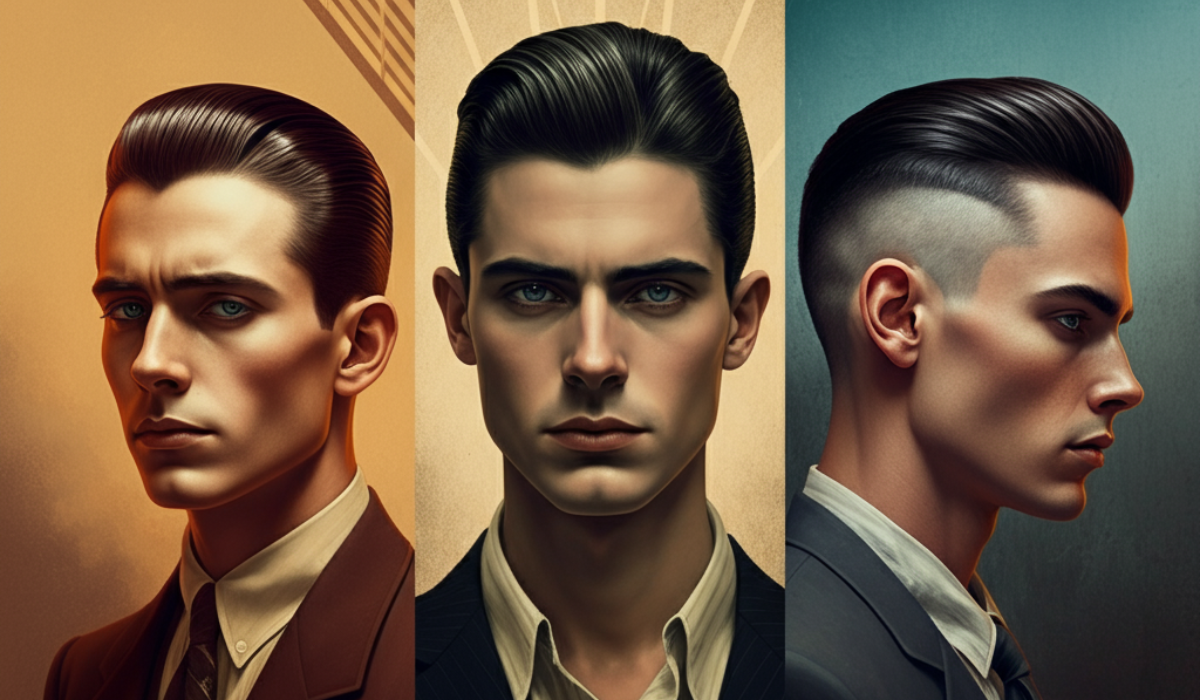Hairstyles have long told a story, reflecting the cultural movements, fashion trends, and personal expressions of their time. From slicked-back sophistication in the 1930s to the statement-making undercuts of 2016, men’s hairstyles have evolved dramatically over the decades. This comprehensive guide walks you through this fascinating timeline, showcasing how men’s hair has transitioned from structured elegance to bold statements of individuality.
Whether you’re a men’s fashion enthusiast, a lover of history, or someone looking for inspiration for your next cut, this evolution through time promises to offer some insight (and perhaps a bit of nostalgia).
Early 20th Century Hairstyles
1930s: The Glamorous Era
The 1930s were all about class and control and men’s hairstyles were no exception. This era was defined by a polished, slicked-back look, achieved with longer hair at the top and shorter sides. Men used hair oils and creams to create the signature glossy finish, ensuring their locks stayed neatly combed all day. The style symbolized sophistication and refinement, channeling the elegance of Hollywood icons like Clark Gable.
1940s: The War Years
With World War II shaping much of the decade’s culture, men’s hairstyles shifted toward practicality without losing their charm. Hair on the top grew slightly longer, creating tasteful volume that hinted at the pompadour styles that would later dominate. A deep side part added structure while maintaining a glossy and polished vibe. Actors like Tyrone Power exemplified this look, merging utility with classic elegance.
The Rise of Counterculture
1950s-1960s: Rock ‘n’ Roll and the Swinging Sixties
The post-war years welcomed an era of experimentation and it all showed in the hair.
- 1950s
Rock ‘n’ roll culture propelled bold hairstyles into the mainstream. Pompadours popularized by icons like Elvis Presley saw men sporting slicked-back hair with voluminous tops, all held together by plenty of gel or Brylcreem for that wet, glossy finish. For more professional settings, the crew cut offered a clean and neat alternative.
- 1960s
Things got a little looser in the ’60s. The era of long hair began with the popular “mop top” look, pioneered by no less than The Beatles themselves. Meanwhile, afros became an iconic representation of style intertwined with identity and empowerment, particularly in the Black community.
The Era of Excess
1970s-1980s: Disco and Big Hair
The 1970s embraced individuality, and hairstyles reflected the decade’s free spirit.
- 1970s
Inspired by hippie culture, long hair became a symbol of rebellion and peace. Men sported flowing locks, dramatic sideburns, and even full beards. Those who participated in disco culture, on the other hand, favored meticulously styled hair paired with bold accessories.
- 1980s
Enter the era of big hair and daring statements. Punk subculture introduced mohawks, spikes, and brightly colored hair, while hip-hop gave rise to the hi-top fade. The mullet—a love-it-or-hate-it phenomenon also became a defining look of the 1980s. Excess and flamboyance were the names of the game.
The Grunge Movement and Beyond
1990s: Grunge and Alternative
Messy, unpolished hairstyling reached its peak in the 1990s, influenced by grunge culture. Think Kurt Cobain’s effortlessly undone layers or Johnny Depp’s curtained hair. Longer, textured looks dominated, while flat-top hairstyles and cornrows carried over from the previous decades. Hair became more reflective of personal style, with neatness taking a backseat to self-expression.
2000s-2010s: Diversity and Individuality
The turn of the century saw an explosion of unique, individualistic styles.
- 2000s
Emo hairstyles defined the early 2000s, with side-swept bangs, flat irons, and dark color palettes. Chunky highlights and spiky hair also made an appearance. Celebrities like Zac Efron embodied the polished-yet-playful aesthetic of the time.
- 2010s
A shift toward natural textures emerged by the 2010s. Men embraced their natural hair—whether curly, wavy, or straight. The focus was on creating effortlessly styled looks devoid of over-grooming.
Modern Men’s Hairstyles
2016: The Year of Personal Style
By 2016, self-expression reached new heights, thanks in part to social media influencing fashion trends. The undercut became a major player, offering men a polished look that could transition seamlessly between professional and casual settings.
The undercut features a shaved or faded side with long locks on top, lending itself to countless styling options from textured quiffs to slicked-back sophistication. Personalization and individuality became the gold standards for modern men’s hairstyles, reflecting confidence in one’s identity.
FAQs About Men’s Hairstyles
Why were hair oils and creams so popular in earlier decades?
Hair oils and creams like Brylcreem were essential in the 1930s-1950s for achieving sleek, polished hairstyles. These products added shine, held styles in place, and controlled frizz, which was crucial for maintaining neatness.
What inspired the “mop top” trend of the 1960s?
The mop top gained popularity thanks to The Beatles, who championed the relaxed, long-on-the-top look. It challenged traditional, close-cropped styles and aligned with the decade’s push for self-expression.
Do the hairstyles of the past influence today’s trends?
Absolutely! Modern styles often reinvent iconic looks, such as adapting the pompadour with a contemporary twist or reviving the undercut for today’s fashion-forward individuals.
How do I maintain an undercut hairstyle?
An undercut requires regular maintenance, including frequent trims to keep the contrast between the shaved sides and long top looking sharp. Styling typically involves pomades, gels, or clays to achieve a desired finish.
The Takeaway
Men’s hairstyles have mirrored every major cultural shift in history, showcasing the evolution from structured elegance to dynamic individuality. Whether drawn to classic slick-backs or edgy undercuts, today’s options are limitless, offering something for every personality and occasion.
To explore your next hairstyle inspiration further, don’t forget to share this guide with your fashion-savvy friends or consult with your barber to channel the perfect look for you. Style isn’t just a reflection of the times it’s a reflection of YOU.

